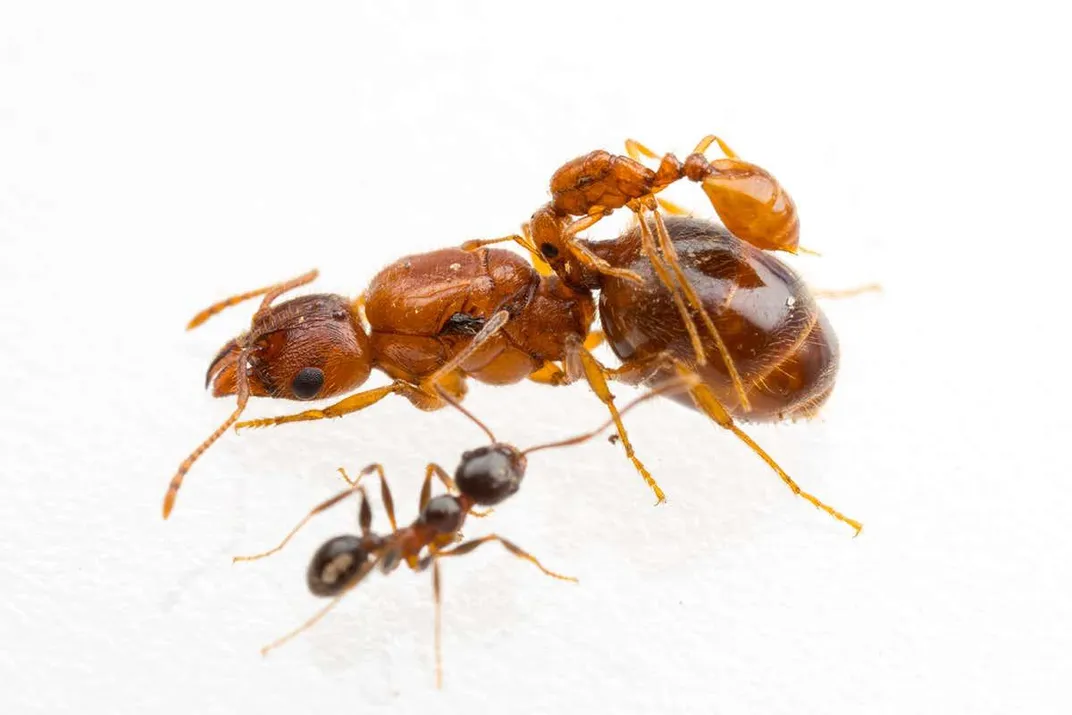Texan ‘Rodeo Ants’ Ride on the Backs of Bigger Ants
The strategy helps the parasitic riders steal food and childcare from their hosts
/https://tf-cmsv2-smithsonianmag-media.s3.amazonaws.com/filer/56/71/5671d44a-79dc-4d9c-8871-36a293233bdd/120619_sm_rodeoant_feat-1028x579.jpg)
In Texas, even the ants saddle up for a good, old-fashioned rodeo.
The Lone Star State is home to so-called “rodeo ants” that ride on the backs of other ants. But when these six-legged jockeys mount a bucking bronco, they do far more than simply hitch a ride. Two new rodeo ant species, recently described by University of Texas at Austin entomologists Alex Wild and Jen Schlauch, appear to be parasites, pilfering food from their perches and tricking them into babysitting the rider’s eggs, reports Susan Milus for Science News.
This scam-heavy strategy might afford these rodeo ants—which appear to be queens—the luxury of an unusually solitary lifestyle, reports Clare Wilson at New Scientist. Most ant queens hold dominion over a large colony of workers, who forage for food, guard their home and tend to her majesty’s eggs. Though the queen is typically the only fertile permanent resident of the nest, she depends heavily on her cadre of companions to get by.
Not so for rodeo ants, which, as far as Wild and his students can tell, appear to ride and live solo. The researchers have so far only uncovered one individual from each of the two newly described species, which have yet to be given formal scientific names. Both were queens, and each conspicuously lacked an entourage.
Though Wild coined the term “rodeo ants,” these specimens aren’t the first ants to climb onto other bugs. Since 1992, scientists have identified females from at least two other ants, both assigned to the genus Solenopsis, that use their mouths to clamp onto the waists of queens from other, bigger species.

The riders’ goal, it seems, is to mooch off the resources of their rides. Once ferried back to a typical ant colony, they become unrepentant freeloaders. They’ll raid the food supply, then lay eggs in the hopes of duping local workers into providing free childcare. Each of these hangers-on is “a parasite on the food and labor of the host colony,” Wild tells Wilson.
A similar modus operandi likely applies to the two newest members of club Rodeo Ant, one of which probably also belongs to the Solenopsis group. Wild uncovered the first in March of 2017, while casually strolling the grounds of Texas’ Brackenridge Field Laboratory. As entomologists are wont to do, Wild flipped a rock on a whim, revealing a colony of large ants. Nothing out of the ordinary for an ant biologist—except for the fact that the colony’s queen appeared to be a double-decker. “I was most surprised to find something on [her] back,” Wild tells Milus.
Soon after, Wild’s student, Jen Schlauch, uncovered a second species, atop another type of ant. Though there were notable differences between each host-parasite pair, the riders sported features that appeared to match their mounts, including the density of hairs on each ant’s back. Features like this, Milus reports, may play a role in helping these insect interlopers blend into the herd.
Getting up close and personal with a colony’s queen may also allow the riders to perfume themselves in some of the chemicals she secretes, further disguising them from the rest of the nest, Nigel Franks, an animal behaviorist and ant expert at the University of Bristol in the United Kingdom who wasn’t involved in the work, tells Wilson.
There’s a lot left to be learned about these two species and their schemes, which have yet to be spotted outside Austin. But given their wild ways, these buggy buckaroos might be worth the trip. As Wild wrote on Twitter, “No insect is more Texan than the Rodeo Ant.”
/https://tf-cmsv2-smithsonianmag-media.s3.amazonaws.com/accounts/headshot/10172852_10152012979290896_320129237_n.jpg)
/https://tf-cmsv2-smithsonianmag-media.s3.amazonaws.com/accounts/headshot/10172852_10152012979290896_320129237_n.jpg)